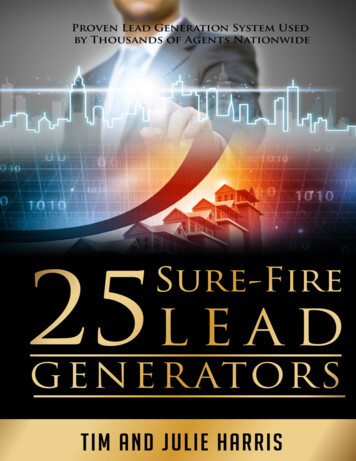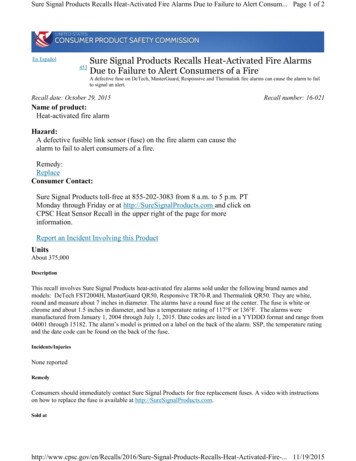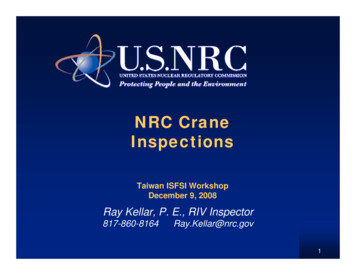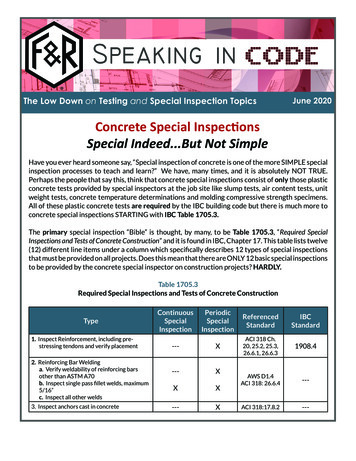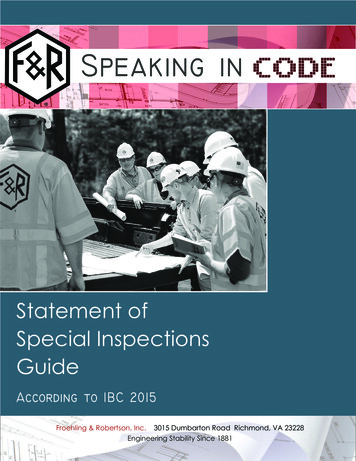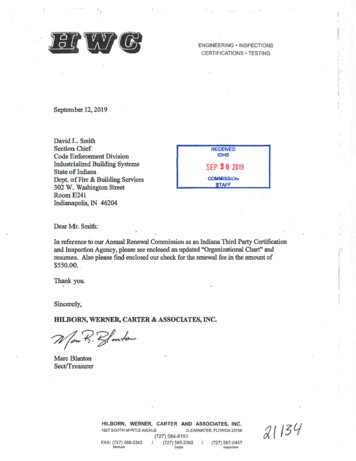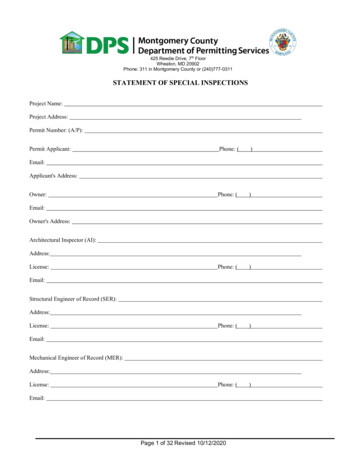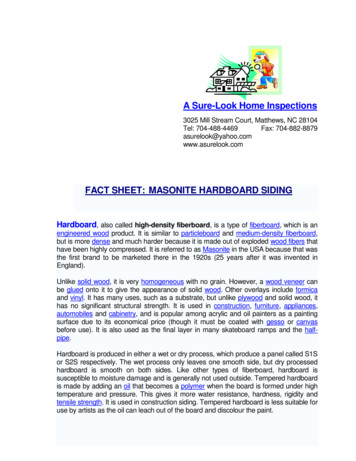
Transcription
A Sure-Look Home Inspections3025 Mill Stream Court, Matthews, NC 28104Tel: 704-488-4469Fax: CT SHEET: MASONITE HARDBOARD SIDINGHardboard, also called high-density fiberboard, is a type of fiberboard, which is anengineered wood product. It is similar to particleboard and medium-density fiberboard,but is more dense and much harder because it is made out of exploded wood fibers thathave been highly compressed. It is referred to as Masonite in the USA because that wasthe first brand to be marketed there in the 1920s (25 years after it was invented inEngland).Unlike solid wood, it is very homogeneous with no grain. However, a wood veneer canbe glued onto it to give the appearance of solid wood. Other overlays include formicaand vinyl. It has many uses, such as a substrate, but unlike plywood and solid wood, ithas no significant structural strength. It is used in construction, furniture, appliances,automobiles and cabinetry, and is popular among acrylic and oil painters as a paintingsurface due to its economical price (though it must be coated with gesso or canvasbefore use). It is also used as the final layer in many skateboard ramps and the halfpipe.Hardboard is produced in either a wet or dry process, which produce a panel called S1Sor S2S respectively. The wet process only leaves one smooth side, but dry processedhardboard is smooth on both sides. Like other types of fiberboard, hardboard issusceptible to moisture damage and is generally not used outside. Tempered hardboardis made by adding an oil that becomes a polymer when the board is formed under hightemperature and pressure. This gives it more water resistance, hardness, rigidity andtensile strength. It is used in construction siding. Tempered hardboard is less suitable foruse by artists as the oil can leach out of the board and discolour the paint.
Hardboard was invented by Daniel Manson Sutherland in 1898, at Sunbury Common inSpelthorne near London. He formed the Patent Impermeable Millboard Company tomarket and develop his invention.Masonite is a type of hardboard formed using the Mason method (invented by WilliamH. Mason) by taking wooden chips and blasting them into long fibres using steam andthen forming them into boards. The boards are then pressed and heated to form thefinished boards. No glue or other material is added. The long fibres give Masonite a highbending strength, tensile strength, density and stability.Masonite was invented in 1924 in Laurel, Mississippi. Manufacturing started in 1929. Inthe 1930s and 1940s Masonite was used for many things like roofing, walls, desktops,electric guitars, canoes, etc. Later, the popularity faded, but it is still used, most notablyby hobbyists. Artists have often used it as a support for painting, and in artistic mediasuch as linocut printing. Masonite's smooth surface makes it a suitable material for tabletennis tables and skateboard ramps. Masonite is also popular among theater companiesas an inexpensive way to construct walls on-stage.Moving companies are large users of Masonite. Their use applications are varied,ranging from protecting the walls of buildings they are moving in and out of and laiddown on the floors and halls of office buildings to enable the smooth rolling of theirdollies loaded with packed goods. A large move can entail many hundreds of 4 x 8 footsheets.Masonite is widely used in the construction industry, particularly in high-end customrenovations where floors are often finished ahead of other work and require protection.1/8" or 1/4" masonite sheets are typically laid over rosin paper on top of finished floorsurfaces in order to adequately protect floors. Seams of masonite sheets are taped withduct tape to keep them from shiftng and to help keep substances from leaking through.It is also called Marsonite. In Europe, this product is also known as Isorel.Product Identification of Masonite Hardboard Siding:Masonite Corporation is a leading manufacturer of a product made from wood fiber, wax andresins that is widely known as hardboard siding. Masonite distributes its hardboard sidingboth in lap (board) and panel (sheet) applications, each available in various external texturesdesigned to look like conventional lumber siding. Masonite markets its siding products for avariety of external construction uses, including exterior siding for residential and otherstructures. This lawsuit does not concern Masonite products used for interior, roof, wallsubstrate, plywood or deck sheathing, or for purposes other than exterior siding. The lawsuitalso does not concern oriented-strand board (OSB) siding.
Not all hardboard siding is manufactured by Masonite Corporation. The Masonite name isoften used improperly to refer to other manufacturers' brands of hardboard siding.Masonite is a registered trademark of Masonite Corporation.If you do not already know whether you have Masonite Hardboard Siding on yourproperty, there are several steps you may take to make that determination. You may wish tocontact the builder of your property; you may remove a board or sheet of the siding andinspect the reverse side; or, if you have a garage with the back side of the siding exposed,you may look there. Masonite Hardboard Siding is typically identified by a stamp of thename "Masonite" and/or the number "X-90" on the siding itself. You may also take a pieceof your siding to your local building supply store, which may be able to assist you.Sample Masonite Siding PicturesThis is from a home built in1983 by Village Builders inHouston TX. This is a panelsiding called Cypress.Notice the V groove on theleft and the cypress features.6" Smooth LapSmooth finish. Looks similiarto woodsmand lap.
Countryside LapThis is called countryside lapsiding. Came from a home inNorth Houston. Triple lap.Looks like 3 boards puttogether. Notice the verticallines.Hiddenridge LapThis is a sample from ahome in Houston.Notice thesmooth texture and the tripleboard look of the siding.Woodsman PanelThis an example ofwoodsman panel siding.Notice the dark colors whichis "wax bleed". Also notie thehorizotal lines in the pattern.
Woodsman 8"LapAnother good example ofoverall damage to siding.this example is fromMissouri City Texas. A homebuilt by Ryland Homes.Notice the swelling aroundthe nail homes, the fungusgrowth at the bottom right.Omniwood LapThis is an example ofOmniwood siding. Notice theswelling around the nails inthe middle of the picture.Stuccato PanelThis is an example ofStuccato by Masonite. Itlooks like stucco.
WoodsmanPanel.Notice the horizontal linesand the "tent" like verticalgroove.Various Siding MarkingsIdentifying the type of siding you have is the hardest part of the entire process.To find the markings: Pull a board off the house and look at the back. Look for markings andnotice the color and texture.Go to an unfinished part of the house like in a garage or attic. Pull back theprotective tar paper and look for markings.Look for samples left in the attice or in the rafters of the garage.Besides finding the manufacturer's markings on the back (see picturesbelow) or identifying the pattern, you can also match the AmericanHardboard Association codes stamped on the boards. Look for the AHAmarkings and use the following tables to help you.
8AHA09AHA010AHA011AHA012AHA013AHA01419AHA20See below for more pictures.PlantOwnerLocationInternationalBosie CascadeFalls, MNBroken Bow,WeyerhaeuserOKDiboll, TXTempleRoaring River,Abitibi/ABTCO, LPNCForest Grove,ForestexORLaurel, MSMasonite, IPChampion, GPCatawba, SCBowwater, USPlywoodUkiah, CAMasonite, IPNot used forNot used for sidingsidingKlamath Falls,WeyerhaeuserORSturgeonMacMillan,Falls, ONTWeyerhaeuserTowanda, PAMasonite, IPNot usedNot usedNot used forNot used for sidingsidingKlamath Falls,CollinsOR
MasoniteThese are examples ofmarkings you could find onthe back of various sidingproducts. In some cases Ihave not found anymarkings on the siding of acomplete home. The one tothe left is obviouslyMasonite.WeyerhaeuserSidingNotice the AHA 10 and thetree in a triangle orsomething that looks like abig A.Temple-InlandThis is a sample of TempleInland siding from a DavidWeekley home in Houston,TX. notice the smooth, darktexture and the INLANDwhich is very noticable.TempleIndustriesThis is a sample from panelsiding. Notice the cluster ofTs connected together incircle.OmniwoodNotice the works "MasoniteOmniwood" and then noticethe pattern. Wood chpsglued together. Small toothpick pieces of wood chips.
LP Inner SealNotice the pieces of sidingglued to gether. Notice thewood chips are bigger thandthe Omniwood siding.LP Inner-Seal.Same piece as above, butnotice the APA and the LPInner-Seal label.ABITIBI-PRICEThisis a close up of AbitibiPrice. Notice the coursepattern on the back.
Siding PatternsThis is a close up of aMasonite productcalledWoodsman lap siding.Notice the waffle iron patternor burlap pattern. I haveseen this on different typesof Masonite. Notice the coloralso and texture.X-90Here is a sample ofMasonite with the X-90markings. Notice how theletters are made with aseries of dots.More X-90Here is another sample of X90 on Masonite brandsiding.
Boise CascadeThis is from a home built byVillage Builders in the mid80's with Boise Cascade 12"lap siding. Notice the circlearound the tree.Backside ofMasonite 6"Smooth LapThis is the 90 in X-90. Noticehow the back is smooth. Nowaffle iron pattern likeabove.Champion Stampon the siding ofplywood
Examples of "Damaged" SidingThese are examples of what is considered "damaged" siding. The definitions come from theMasonite settlement document. Most all of the settlements include these types of damages.Swelling around thenail holes.Surface welting, or swelling aroundnail heads This example is from aMasonite Woodsman lap siding.Look at a picture of siding withoutswelling around the nails.Buckling of Sidingin excess of 1/4" between studsspaced not more than 18" oncenter;Edge CheckingEdge checking, where a feelergauge of .025" thickness and onehalf inch width can be insertedone-half inch into a suspecteddelaminated edge with moderatehand pressure;(horse shit! The inspectors do notand have not used a feeler gaugeon any house I've seen inspected.)Look at a good edge of siding.
Thickness Swelling.Thickness swell in excess of 15%of the maximum ANSI/AMA 135.6standard tolerance, that is, ameasure of .065" for siding with anominal thickness of one- halfinch and .518" for boards with anominal thickness of 7/16 inch;Fungal Degradationfungal degradation which results insoft board in which moderatethumb pressure deforms orpunches a hole in the board;Wax Bleed.wax bleed, raised or popped fibersor fiber bundles, where thecondition exists on more than 25%of the board surface and, in thecase of wax bleed, where theSiding in question was paintedwithin four years of the date of theinspection. "Wax bleed" does notinclude paint discoloration;
Masonite Hardboard Siding Settlements:Note: This settlement was approved on Jan 1, 1998 and was to continue for many homes till2008 BUT.according to the settlement "After seven (7) years from the Settlement Date,Defendants had the option to terminate this agreement." This settlement was completed by2005. This settlement paid qualified homeowners for damaged siding. It was not the bestsettlement for the homeowners, but considering the alternatives it was the best homeownersgot.Structures Affected: 4.3 Million across the US. (Mobile Register)Web site: www.masoniteclaims.comArticles: Masonite: Godzilla of class actions A must read article from the Mobile Register.Mobile Alabama is where the trial took place.Phone: 1-800-330-2722Attorneys: John Crowder and Richard Dorman, 1-800-3509315Compliments of:Gary WilliamsA Sure-Look Home InspectionsInspections you can trust!3025 Mill Stream Ct.Matthews, NC 28104Phone: (704) 488 4469Fax; (704) 882 8879www.asurelook.com
Product Identification of Masonite Hardboard Siding: Masonite Corporation is a leading manufacturer of a product made from wood fiber, wax and resins that is widely known as hardboard siding. Masonite distributes its hardboard siding both in lap (board) and panel (sheet)




